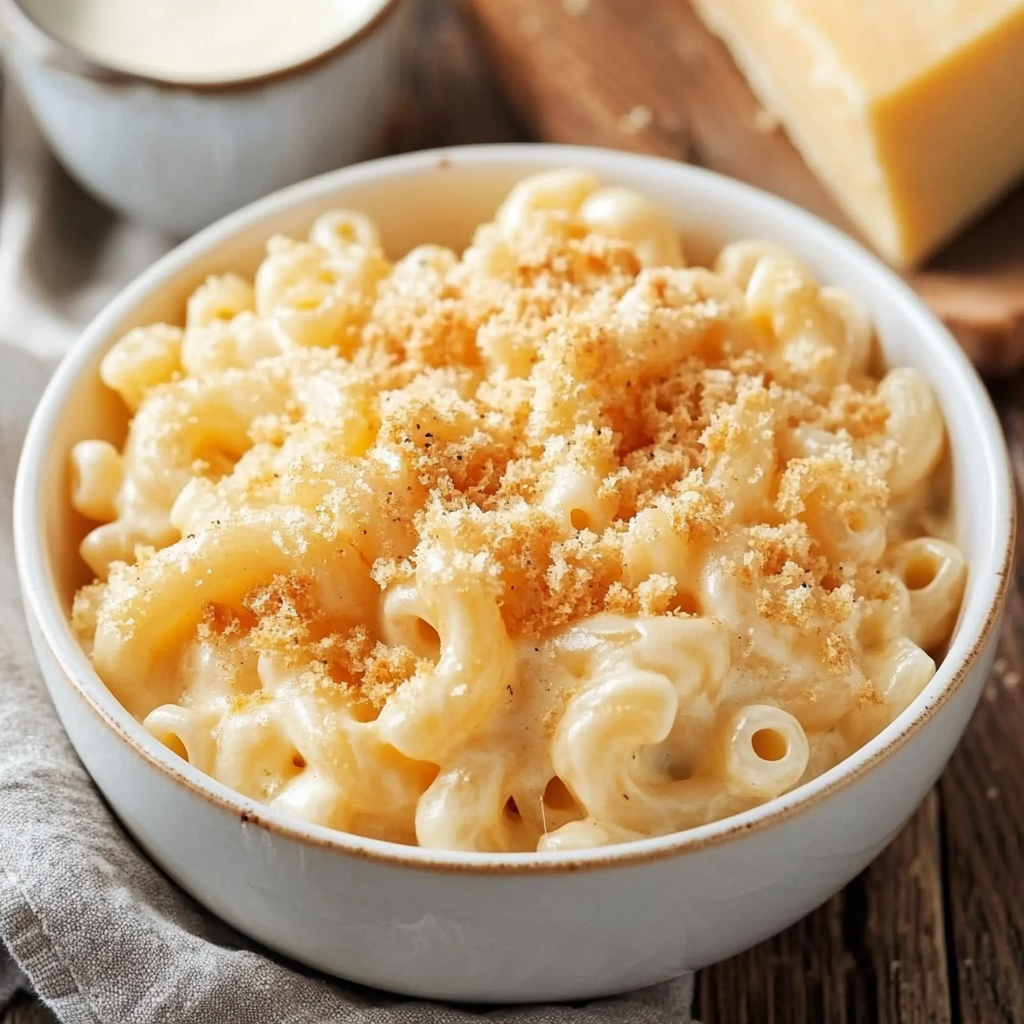Sharing is caring!
Mac and Cheese Recipe
Why You’ll Love Mac and Cheese?
There’s nothing quite like a warm, creamy bowl of mac and cheese to bring comfort to any meal. Whether you’re craving a nostalgic childhood favorite or a quick weeknight dinner, this classic dish delivers rich, cheesy goodness in every bite. Perfect for cozy nights in or potluck gatherings, mac and cheese is a crowd-pleaser that never goes out of style. Plus, with endless variations—from baked to stovetop—you can customize it to suit any taste. If you love creamy, indulgent dishes, you’ll adore our creamy garlic chicken too!
Table of Contents
- Ingredients to make mac and cheese
- Time needed to make mac and cheese
- Quick Steps to Make Mac and Cheese
- Is mac and cheese healthy and nutritious
- Can I make mac and cheese healthier and still delicious
- How to Serve Mac and Cheese
- Avoid These Mistakes
- The best way to store leftover mac and cheese
- Ready to give mac and cheese a try
- Frequently Asked Questions
Ingredients to make mac and cheese
- 8 oz elbow macaroni (or any short pasta)
- 2 cups shredded sharp cheddar cheese
- 1 cup shredded mozzarella cheese
- 2 cups whole milk
- 2 tbsp unsalted butter
- 2 tbsp all-purpose flour
- ½ tsp garlic powder
- ½ tsp onion powder
- ½ tsp mustard powder
- Salt and black pepper to taste
- ¼ cup breadcrumbs (optional, for topping)
Substitution Notes: Use gluten-free pasta and flour if needed. For a richer taste, replace half the milk with heavy cream.
Time needed to make mac and cheese
Craving creamy mac and cheese but short on time? This one-pot wonder comes together in just 30 minutes—perfect for busy weeknights or last-minute comfort food fixes. Here’s the breakdown:
- Prep Time: 5 minutes (grate cheese, measure pasta)
- Cook Time: 20 minutes (simmer pasta, stir in cheese)
- Total Time: 25–30 minutes
For even quicker prep, try pre-shredded cheese or streamline your process with these time-saving kitchen hacks. Want a hands-off version? Slow-cooker mac and cheese takes 2–3 hours but requires minimal effort.
Quick Steps to Make Mac and Cheese
Step 1: Boil the pasta
Bring a large pot of salted water to a boil. Add the macaroni and cook until al dente, about 8-10 minutes. Drain and set aside.
Step 2: Make the cheese sauce
In the same pot, melt butter over medium heat. Whisk in flour to create a roux, cooking for 1-2 minutes until golden. Slowly pour in milk while whisking continuously to avoid lumps.
Step 3: Add the cheese
Reduce heat to low and stir in shredded cheddar cheese until completely melted and smooth. Season with salt, pepper, and a pinch of mustard powder for extra flavor.
Step 4: Combine everything
Return the cooked macaroni to the pot with the cheese sauce. Stir gently until all pasta is evenly coated with the creamy sauce.
Step 5: Serve immediately
For best results, serve your mac and cheese hot. For extra indulgence, top with breadcrumbs and broil for 2-3 minutes until golden and crispy.
Is mac and cheese healthy and nutritious
Mac and cheese is a comfort food favorite, but is it good for you? While traditional versions can be high in calories, fat, and sodium, there are ways to boost its nutritional value. A standard serving of homemade mac and cheese contains around 300–400 calories, 15–20g of fat, and 30–40g of carbs. It also provides protein from the cheese and pasta, along with calcium for bone health.
For a healthier twist, try using whole-grain pasta, which adds fiber, or swap in low-fat cheese to cut calories. You can also sneak in veggies like cauliflower or butternut squash for extra vitamins. If you’re looking for more balanced comfort food, check out this chicken broccoli potato recipe or this vegetable quiche for lighter options.
For expert tips on making nutritious comfort meals, explore slow cooker beef stew or vegan split pea soup for inspiration.
Can I make mac and cheese healthier and still delicious
Absolutely! You can enjoy a lighter version of mac and cheese without sacrificing flavor. Here are some smart swaps to make this comfort food healthier:
Whole Wheat or Chickpea Pasta
Swap regular pasta for whole wheat or chickpea varieties to add fiber and protein. The nutty flavor pairs perfectly with cheese sauce. For more high-protein meal ideas, check out our creamy garlic chicken recipe.
Cauliflower Power
Replace half the pasta with roasted cauliflower florets. They add nutrients while maintaining that creamy texture we love. This trick works great in other dishes too, like our chicken broccoli potato casserole.
Lighter Cheese Sauce
Use sharp cheddar for more flavor with less cheese, and thicken your sauce with pureed butternut squash or carrots. For alternative creamy sauces, this slow cooker technique works wonderfully.
Breadcrumb Alternatives
Instead of buttery breadcrumbs, try crushed nuts or whole grain panko for crunch. If you enjoy creative toppings, you’ll love the crust on this vegan soup that uses similar principles.
Remember, small changes can make a big difference in nutrition while keeping all the comfort food goodness!
How to Serve Mac and Cheese
Mac and cheese is a versatile dish that pairs well with countless sides, drinks, and garnishes. For a classic comfort meal, serve it alongside Mom’s Chicken Pot Pie or a crisp green salad for balance. If you’re hosting a gathering, elevate your spread with Vegetable Quiche for a brunch-friendly combo.
For drinks, a chilled glass of lemonade or iced tea complements the richness, while beer lovers might enjoy a crisp lager. Garnish with fresh herbs like parsley or chives for a pop of color, or add a crunch with toasted breadcrumbs. For more pairing inspiration, check out hearty stews or spiced soups to round out your menu.
Avoid These Mistakes
Making mac and cheese seems simple, but small errors can ruin the dish. Here are common pitfalls and how to dodge them:
Overcooking the Pasta
Cook pasta al dente—it continues softening in the cheese sauce. Mushy noodles ruin texture. For perfect doneness, check out our guide to cooking pasta.
Using Pre-Shredded Cheese
Pre-shredded cheese contains anti-caking agents that make sauces grainy. Always grate your own cheddar or gruyère. Learn why fresh ingredients matter in this slow-cooking guide.
Rushing the Roux
A lumpy roux means lumpy sauce. Whisk constantly over medium heat until smooth. For flawless technique, see our creamy sauce tutorial.
Skipping the Mustard
A teaspoon of mustard powder boosts cheese flavor dramatically. Don’t omit it! Discover more flavor-enhancing tips in this seasoning deep dive.
Baking Without a Topping
Breadcrumbs or extra cheese create essential texture contrast. Try our crunchy topping formula for guaranteed crispiness.
The best way to store leftover mac and cheese
Leftover mac and cheese can stay fresh for up to 3–4 days when stored properly. Transfer it to an airtight container and refrigerate as soon as it cools to room temperature. For longer storage, freeze portions in freezer-safe bags or containers for up to 2 months. When reheating, add a splash of milk or cream to restore creaminess—microwave in 30-second intervals or warm on the stovetop over low heat.
For meal prep, consider making a double batch of this cheesy pasta dish and storing individual servings. If you love creamy comfort foods, check out our creamy chicken recipe for another make-ahead option. For freezing tips, this guide offers great insights, and if you’re exploring dairy-free alternatives, this vegan soup recipe shares useful storage tricks.
Ready to give mac and cheese a try
There’s nothing quite like a warm, creamy bowl of mac and cheese to bring comfort to any meal. Whether you’re cooking for a family dinner or meal prepping for the week, this one-pot wonder is sure to become a favorite. For more cheesy inspiration, check out our loaded bacon cheeseburger pasta or chicken tortilla casserole. If you’re looking for other creamy dishes, our creamy garlic chicken and creamy chicken recipe are must-tries!
Frequently Asked Questions
Can I use different types of cheese in mac and cheese?
Absolutely! While cheddar is classic, you can experiment with Gruyère, Gouda, or even pepper jack for extra flavor. Combining cheeses creates a richer taste.
How do I prevent my mac and cheese from becoming dry?
Ensure your sauce is slightly thinner than desired before baking, as pasta absorbs liquid. Cover with foil for part of the baking time to retain moisture.
Can I make mac and cheese ahead of time?
Yes! Prepare it up to the baking step, refrigerate for up to 2 days, then bake when ready. Add a splash of milk before reheating to refresh the texture.
Is mac and cheese freezer-friendly?
It freezes well for up to 3 months. Thaw overnight in the fridge and reheat in the oven with a little extra milk or cream to restore creaminess.
What’s the best pasta shape for mac and cheese?
Elbow macaroni is traditional, but shells, cavatappi, or penne work great—their nooks hold more cheese sauce for maximum flavor.










